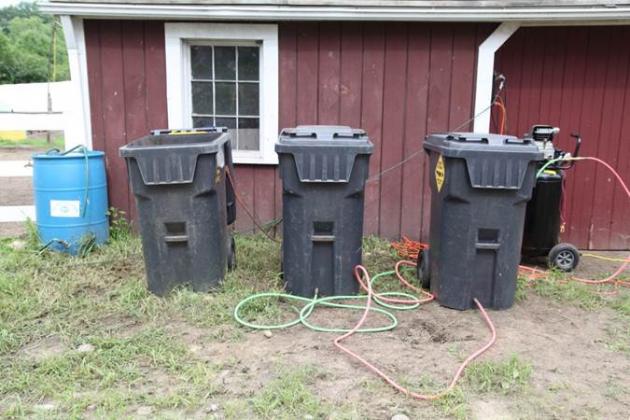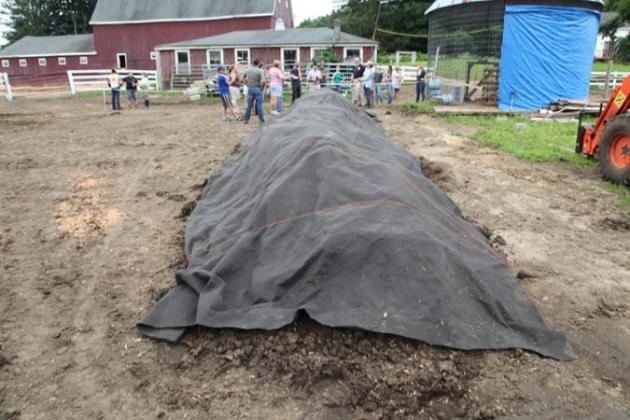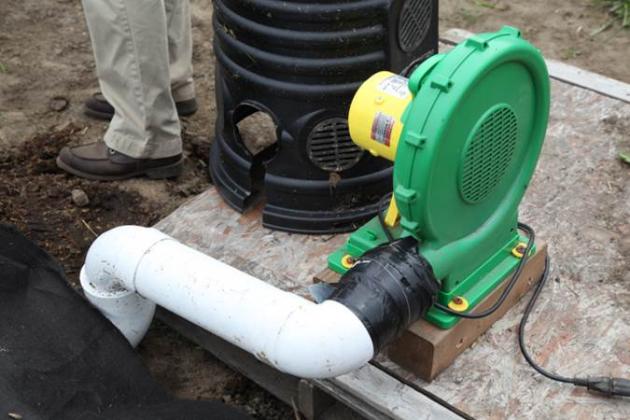Why Study Low-Cost Composting?
The equine industry in Massachusetts, estimated to be over 50,000 animals, is of a size to make significant impact on non-point source pollution. An average horse generates about 45 lb. of manure per day, almost 10 tons per year as well as bedding. Thus, in Massachusetts approximately 500,000 tons of manure plus associated stall bedding are produced each year. Management of manure and mud on horse farms is a challenge for horse owners and equine facility managers. This is of particular concern at farms where horses are kept in stalls and land availability for manure spreading is limited. The growing number and size of unmanaged piles of manure seen on many properties is becoming an increasing concern due to greater public awareness and pressures in an increasingly urban society. Runoff from stables, manure piles and over grazed pastures has the potential to increase risks of non-point source pollution from nutrients, organic particles, fecal coliform bacteria, and other pathogens. Related: Small Farm Stewardship
What did we do?
|
Figure 1: Aerated trash bins system
Figure 2: Perforated wood to be installed at the bottom of the bins for air flow
Figure 3: Composting pile with cover
Figure 4: Automated air blower connected to perforated PVC pipe |
Through a 319s grant funded by Massachusetts Department of Environment Protection, two Aerated Static Pile (ASP) composting systems, also known as forced aeration were installed to manage livestock manure and bedding produced on Blue Star Equiculture Farm in Palmer, Massachusetts. A community-based 501c3 non-profit organization, Blue Star Equiculture was established to provide retired and homeless working horses a sanctuary and the opportunity to improve their lives and be purposeful. The organization also offers equine and environmental awareness to the public through educational and healing opportunities.
Blue Star Equiculture currently manages their manure by hauling it to a nearby field. The Blue Star Equiculture has 30-40 horses at any time and expects an increase in number of animals. Considering an average of 45 lbs/day of raw manure, 35 horses generate a yearly mass of 575,000 lbs (287 tons) of raw manure that affects the Lower Ware River and Chicopee main stem. The current loading of nutrients by the Blue Star Equiculture herd is roughly 4000 lbs/year of nitrogen and 1200 lbs/year of phosphorus. This has implication on macrophyte growth and eutrophication of the Chicopee River.
The wheels under the bins make collection of waste in the stall much easier. This simple and cost efficient system is especially applicable in facilities with 1-3 horses.
The second system consisted of one or more composting piles about 35 ft long (Figure 3). Each pile can be subdivided into three 10 ft section for frequent addition of fresh materials and/or removing finished compost. The composting materials are piled on a wood chip base with perforated PVC pipe running through the base and a 1 HP air pump which works for 1-2 minutes every hour. The pile is covered with a fabric which is impermeable to water. The compost in each subdivision is finished in 8-10 weeks including curing and finishing time. The same blower control and manure sensory system used for the bins was also utilized with the large pile setup.
What have we learned?
Both composting systems worked efficiently and compost was ready in eight weeks. Composting of horse waste at the Blue Star Equiculture significantly reduced pollution related to nutrients and pathogens. Aerated composting systems were used for hands on training workshops where over 400 horse owners learned about these systems and some of them implemented on their farm.
Future Plans
Similar system will be installed at University of Massachusetts Horse Farm to educate students of equine management as well as hundreds of visitors coming to the farm annually.
Authors
Masoud Hashemi, Extension Associate Professor, University of Massachusetts masoud@umass.edu
Atakan Kadi
Additional information
http://ag.umass.edu/sites/ag.umass.edu/files/fact-sheets/pdf/low_cost_ae…
Acknowledgements
This project has been financed partially with federal funds from the US Environmental Protection Agency (EPA) to the Massachusetts Department of Environmental Protection (the Department) under a s319 Competitive Grant. The contents do not necessarily reflect the views and policies of the EPA or of the Deparment, nor does the mention of trade names or commercial products constitute endorsement or recommendation for use.
The authors are solely responsible for the content of these proceedings. The technical information does not necessarily reflect the official position of the sponsoring agencies or institutions represented by planning committee members, and inclusion and distribution herein does not constitute an endorsement of views expressed by the same. Printed materials included herein are not refereed publications. Citations should appear as follows. EXAMPLE: Authors. 2015. Title of presentation. Waste to Worth: Spreading Science and Solutions. Seattle, WA. March 31-April 3, 2015. URL of this page. Accessed on: today’s date.






